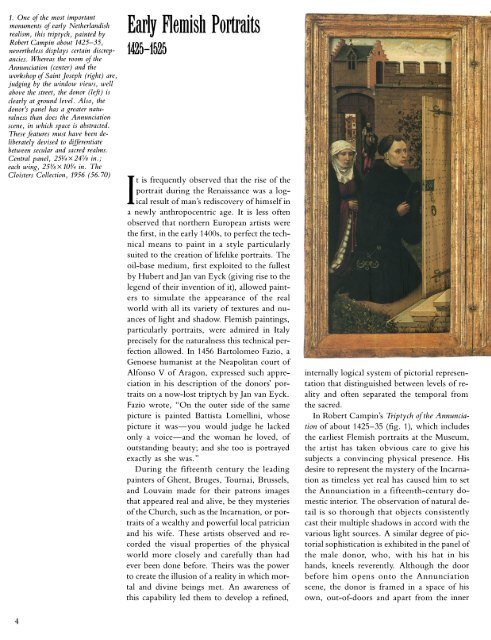Early Flemish Portraits 1425-1525: The Metropolitan Museum of Art ...
Early Flemish Portraits 1425-1525: The Metropolitan Museum of Art ...
Early Flemish Portraits 1425-1525: The Metropolitan Museum of Art ...
You also want an ePaper? Increase the reach of your titles
YUMPU automatically turns print PDFs into web optimized ePapers that Google loves.
1. One <strong>of</strong> the most important<br />
monuments <strong>of</strong> early Netherlandish<br />
realism, this triptych, painted by<br />
Robert Campin about <strong>1425</strong>-35,<br />
nevertheless displays certain discrepancies.<br />
Whereas the room <strong>of</strong> the<br />
Annunciation (center) and the<br />
workshop <strong>of</strong> Saint Joseph (right) are,<br />
judging by the window views, well<br />
above the street, the donor (left) is<br />
clearly at ground level. Also, the<br />
donor's panel has a greater natu-<br />
ralness than does the Annunciation<br />
scene, in which space is abstracted.<br />
<strong>The</strong>sefeatures must have been deliberately<br />
devised to differentiate<br />
between secular and sacred realms.<br />
Central panel, 25/4 x 247/8 in.;<br />
each wing, 253/8 x 103/4 in. <strong>The</strong><br />
Cloisters Collection, 1956 (56.70)<br />
<strong>Early</strong> <strong>Flemish</strong> <strong>Portraits</strong><br />
<strong>1425</strong>-<strong>1525</strong><br />
t is frequently observed that the rise <strong>of</strong> the<br />
portrait during the Renaissance was a logical<br />
result <strong>of</strong> man's rediscovery <strong>of</strong> himself in<br />
a newly anthropocentric age. It is less <strong>of</strong>ten<br />
observed that northern European artists were<br />
the first, in the early 1400s, to perfect the technical<br />
means to paint in a style particularly<br />
suited to the creation <strong>of</strong> lifelike portraits. <strong>The</strong><br />
oil-base medium, first exploited to the fullest<br />
by Hubert and Jan van Eyck (giving rise to the<br />
legend <strong>of</strong> their invention <strong>of</strong> it), allowed painters<br />
to simulate the appearance <strong>of</strong> the real<br />
world with all its variety <strong>of</strong> textures and nuances<br />
<strong>of</strong> light and shadow. <strong>Flemish</strong> paintings,<br />
particularly portraits, were admired in Italy<br />
precisely for the naturalness this technical perfection<br />
allowed. In 1456 Bartolomeo Fazio, a<br />
Genoese humanist at the Neapolitan court <strong>of</strong><br />
Alfonso V <strong>of</strong> Aragon, expressed such appreciation<br />
in his description <strong>of</strong> the donors' portraits<br />
on a now-lost triptych by Jan van Eyck.<br />
Fazio wrote, "On the outer side <strong>of</strong> the same<br />
picture is painted Battista Lomellini, whose<br />
picture it was-you would judge he lacked<br />
only a voice-and the woman he loved, <strong>of</strong><br />
outstanding beauty; and she too is portrayed<br />
exactly as she was."<br />
During the fifteenth century the leading<br />
painters <strong>of</strong> Ghent, Bruges, Tournai, Brussels,<br />
and Louvain made for their patrons images<br />
that appeared real and alive, be they mysteries<br />
<strong>of</strong> the Church, such as the Incarnation, or portraits<br />
<strong>of</strong> a wealthy and powerful local patrician<br />
and his wife. <strong>The</strong>se artists observed and recorded<br />
the visual properties <strong>of</strong> the physical<br />
world more closely and carefully than had<br />
ever been done before. <strong>The</strong>irs was the power<br />
to create the illusion <strong>of</strong> a reality in which mortal<br />
and divine beings met. An awareness <strong>of</strong><br />
this capability led them to develop a refined,<br />
internally logical system <strong>of</strong> pictorial representation<br />
that distinguished between levels <strong>of</strong> reality<br />
and <strong>of</strong>ten separated the temporal from<br />
the sacred.<br />
In Robert Campin's Triptych <strong>of</strong> the Annunciation<br />
<strong>of</strong> about <strong>1425</strong>-35 (fig. 1), which includes<br />
the earliest <strong>Flemish</strong> portraits at the <strong>Museum</strong>,<br />
the artist has taken obvious care to give his<br />
subjects a convincing physical presence. His<br />
desire to represent the mystery <strong>of</strong> the Incarnation<br />
as timeless yet real has caused him to set<br />
the Annunciation in a fifteenth-century domestic<br />
interior. <strong>The</strong> observation <strong>of</strong> natural detail<br />
is so thorough that objects consistently<br />
cast their multiple shadows in accord with the<br />
various light sources. A similar degree <strong>of</strong> pictorial<br />
sophistication is exhibited in the panel <strong>of</strong><br />
the male donor, who, with his hat in his<br />
hands, kneels reverently. Although the door<br />
before him opens onto the Annunciation<br />
scene, the donor is framed in a space <strong>of</strong> his<br />
own, out-<strong>of</strong>-doors and apart from the inner

















